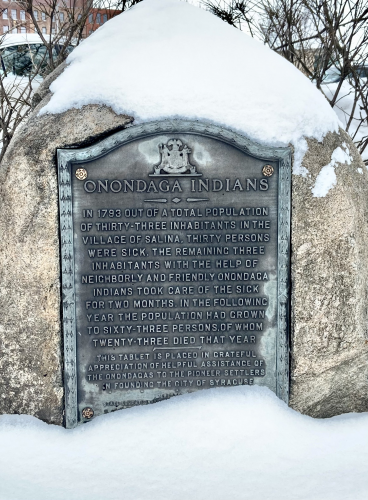A Time for Mercy
David Freund, Chief Leadership Officer

The year is 1793. A village called Salina sits atop a swamp near the shores of Onondaga Lake. The population of Salina equals 33 people who spend their days boiling brine to make salt. Each year, the swamp becomes a breeding ground for mosquitoes carrying all sorts of disease, sometimes leading to death. 1793 was a particularly deadly year. Of the 33 inhabitants, 30 became sick, leaving only the remaining three to care for the sick and maintain the salt production. How did the village ever survive?
According to historical archives, the village was saved by Patrick Riley, one of the workers at the salt mine who kept the vats boiling while caring for the sick. These same records also indicate that a Dr. David Holbrook from nearby Jamesville would ride into the village to care for the fever-stricken villagers. What is less known is that the survival of this small village that would someday become the city of Syracuse was in large part due to the efforts of the neighbors to the south, the “Firekeepers“ of the Six Nations, the Onondagas. Knowing the village was facing illness and starvation, the Onondagas brought fish and venison and helped care for their neighbors to the north.
Why would a people who, 14 years earlier, had their village and cornfields burned during the Revolutionary War help these dying settlers? Why, after suffering devastating losses due to smallpox brought over by Europeans, would they offer help to these fever ravaged settlers? Why would a people who had suffered so much worry about European settlers? According to an interview with Leon Shenandoah that appeared in the Post Standard on November 22, 1994, it was the logical thing to do. “It comes into what we believe,” said Shenandoah. “When I was sitting with my elders, they said you need to treat everyone well. That’s according to the Creator.” What a wonderful teaching. The Onondagas were taught to treat others well and not reward evil with evil. They were taught that you could overcome evil with good. A lesson that leaders need to learn and implement today.
Just east of the old Syracuse Savings Bank building, at the intersection of Erie Blvd., Montgomery St., and Oswego Blvd., is a small stone monument. The monument was dedicated in 1935 as a lasting reminder of the power of forgiveness and the blessing of community. In a time when there is so much hatred and division, we could all benefit from a visit to this monument. Take the time to read the plaque, reflect on the kindness and love shown by our neighbors, and then pursue a path to a better future.
So what ever happened to the village of Salina? By 1794, the population rose to 63, and 23 of them passed away. Without the help and mercy of the Onondagas they all would have perished. Who knows what that would have meant for the future of our great city. History is full of people who chose to change their world through acts of kindness and valuing others. Will you step up and help change your world?
If you would like to hear more about the amazing history behind his monument, please join Marisa Norcross and me for Episode 190 of The Next Page podcast.
Download The Next Page Here: iTunes | Google Play | PodBean